成人高考英语复习资料
- 格式:doc
- 大小:233.00 KB
- 文档页数:44
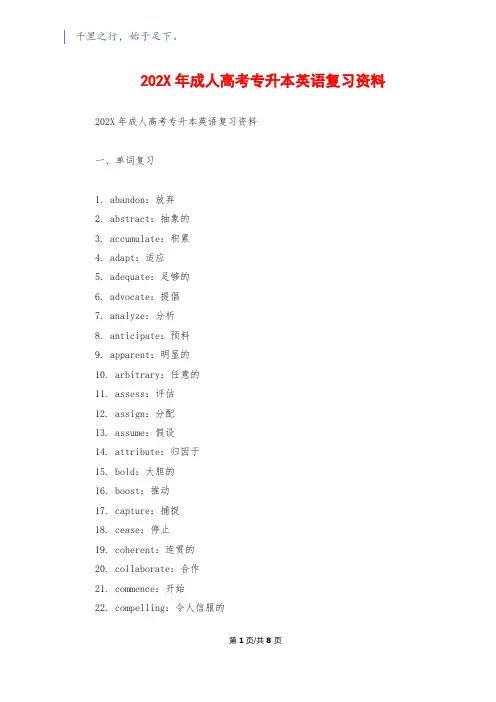
202X年成人高考专升本英语复习资料202X年成人高考专升本英语复习资料一、单词复习1. abandon:放弃2. abstract:抽象的3. accumulate:积累4. adapt:适应5. adequate:足够的6. advocate:提倡7. analyze:分析8. anticipate:预料9. apparent:明显的10. arbitrary:任意的11. assess:评估12. assign:分配13. assume:假设14. attribute:归因于15. bold:大胆的16. boost:推动17. capture:捕捉18. cease:停止19. coherent:连贯的20. collaborate:合作21. commence:开始22. compelling:令人信服的第1页/共8页23. comprehensive:全面的24. consistent:一致的25. convert:转换26. correspond:相符27. crucial:关键的28. cultivate:培养29. debate:辩论30. decline:下降二、常见短语1. above all:首要的是2. according to:根据3. as a result:结果4. as far as:就……而言5. as long as:只要6. as soon as:一……就7. as well as:以及8. at first glance:乍一看9. at the same time:同时10. be accustomed to:习惯于11. be aware of:意识到12. be capable of:能够13. be connected with:与……有关14. be devoted to:致力于15. be exposed to:暴露于16. be in favor of:支持17. be known for:以……而闻名18. be related to:与……有关19. be responsible for:对……负责20. be subjected to:遭受21. be worth doing:值得做22. by means of:通过23. by no means:绝不24. by virtue of:凭借25. come into being:产生26. come to an end:结束27. give rise to:引起28. have access to:有权使用29. make an effort:努力30. put emphasis on:强调三、重点语法1. 一般现在时肯定句:主语 + 动词原形 + 其他。
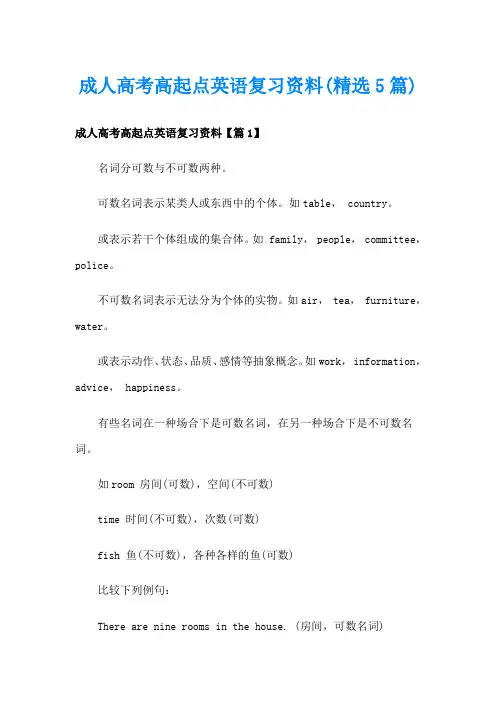
成人高考高起点英语复习资料(精选5篇)成人高考高起点英语复习资料【篇1】名词分可数与不可数两种。
可数名词表示某类人或东西中的个体。
如table, country。
或表示若干个体组成的集合体。
如 family, people, committee,police。
不可数名词表示无法分为个体的实物。
如air, tea, furniture,water。
或表示动作、状态、品质、感情等抽象概念。
如work, information,advice, happiness。
有些名词在一种场合下是可数名词,在另一种场合下是不可数名词。
如room 房间(可数),空间(不可数)time 时间(不可数),次数(可数)fish 鱼(不可数),各种各样的鱼(可数)比较下列例句:There are nine rooms in the house. (房间,可数名词)There isnt enough room for us three in the car . (空间,不可数名词)不可数名词的数量可以通过在其前面加单位词来表示。
如:一块肉 a piece of meat两条长面包 two loaves of bread三件家具 three articles of furniture一大笔钱 a large sum of money成人高考高起点英语复习资料【篇2】1.表示特定的人或东西。
Give me the magazine.Have you decided on the prices yet?The book on the table is an English dictionary.Beijing is the capital of China.2.复述前文提到的人或东西。
Last week, I saw a flim. The film is about a love story between two middle-aged people.The old man saw a house in the field. He went into the house and found a beautiful girl sitting there and singing.3.用于形容词前面,代表一类人或东西。
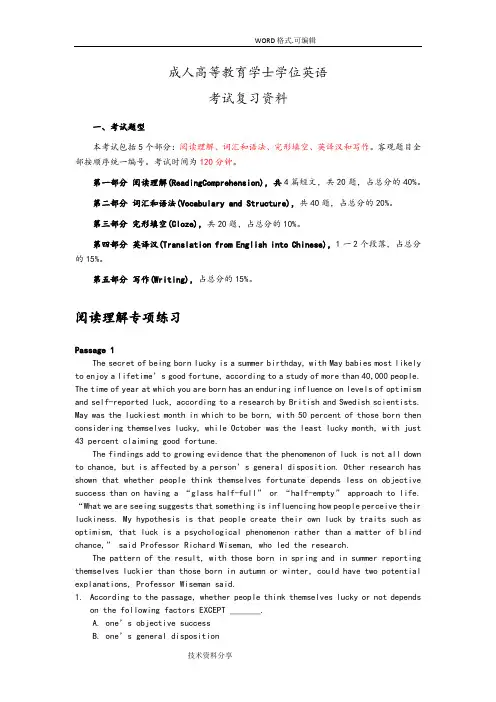
成人高等教育学士学位英语考试复习资料一、考试题型本考试包括5个部分:阅读理解、词汇和语法、完形填空、英译汉和写作。
客观题目全部按顺序统一编号。
考试时间为120分钟。
第一部分阅读理解(ReadingComprehension),共4篇短文,共20题,占总分的40%。
第二部分词汇和语法(Vocabulary and Structure),共40题,占总分的20%。
第三部分完形填空(Cloze),共20题,占总分的10%。
第四部分英译汉(Translation from English into Chinese),1一2个段落,占总分的15%。
第五部分写作(Writing),占总分的15%。
阅读理解专项练习Passage 1The secret of being born lucky is a summer birthday, with May babies most likely to enjoy a lifetime’s good fortune, according to a study of more than 40,000 people. The time of year at which you are born has an enduring influence on levels of optimism and self-reported luck, according to a research by British and Swedish scientists. May was the luckiest month in which to be born, with 50 percent of those born then considering themselves lucky, while October was the least lucky month, with just 43 percent claiming good fortune.The findings add to growing evidence that the phenomenon of luck is not all down to chance, but is affected by a person’s general disposition. Other research has shown that whether people think themselves fortunate depends less on objective success than on having a “glass half-full” or “half-empty” approach to life. “What we are seeing suggests that something is influencing how people perceive their luckiness. My hypothesis is that people create their own luck by traits such as optimism, that luck is a psychological phenomenon rather than a matter of blind chance,” said Profe ssor Richard Wiseman, who led the research.The pattern of the result, with those born in spring and in summer reporting themselves luckier than those born in autumn or winter, could have two potential explanations, Professor Wiseman said.1.According to the passage, whether people think themselves lucky or not dependson the following factors EXCEPT _______.A. one’s objective successB. one’s general dispositionC. one’s attitude to lifeD. one’s place of birth2. According to the passage, those who were born in ________ regard themselves as the most fortunate.A. MarchB. AprilC. MayD. October3. Which of the following statements is TRUE according to the passage?A. Optimistic people tend to be luckier.B. Devoted people tend to be luckier.C. Objective success is more important than one’s general disposition in feeling lucky.D. People drinking more water tend to be luckier.4. Which of the following words can be best replace the word “trait” (Line7, Para.2)?A. Quality.B. Expectation.C. Belief.D. Idea5. What is the best title for the passage?A. Luck is Something BornB. Luck is Not All Down to ChanceC. Luck is a Matter of Blind ChanceD. Luck and AgePassage 2Man has always wanted to fly. Some of the greatest men in history had thought about the problem. One of them, for example, was the great Italian artist, Leonardo Da Vinci. In the 16th century he made designs for machines that would fly, but they were never built.Throughout history, other less famous men had wanted to fly. An example was a man in England 800 years ago. He made a pair of wings from chicken feathers. Then he fixed them to his body and jumped into air from a tall building. He did not fly very far. Instead, he fell to the ground and broke every bone of his body and rested in peace.The first real step took place in France, in 1783. Two brothers, the Montgolfiers, made a very large “hot air balloon”. They knew that hot air rises. Why not fill a balloon with it? The balloon was made of cloth and paper. In September of that year, the King and Queen of France came to see the balloon. They watched it carry the very first air passengers into the sky. The passengers were a sheep and a chicken. We do not know how they felt about the trip. But we do know that the trip lasted eight minutes and that the animals landed safely. Two months later, two men did the same thing. They rose above Paris in a balloon of the same kind. Their trip lasted twenty-five minutes and they traveled about.1. Leonardo Da Vinci _______.A. said that man would fly in the sky one dayB. built a kind of machine which never flewC. made designs for flying machinesD. drew many beautiful pictures of birds2. Eight hundred years ago an Englishman _______.A. made a kind of flying machineB. tried to fly with wings made of chicken feathersC. wanted to build a kind of balloonD. tried to fly on a large bird3. In fact, the Englishman who tried to fly _______.A. got badly woundedB. succeeded in flyingC. lost his lifeD. flew only 8 minutes4. The very first air passengers in the balloon were _______.A. two animalsB. the MontgolfiersC. two FrenchmenD. the King and Queen5. When did two Frenchmen rise above Paris?A. In December 1783.B. In September 1783.C. In the 17th century.D. In November 1783.Passage 3Dieting to lose weight has become very popular in recent years. People have become more health conscious and try to take better care of their bodies by eating more nutritiously(有营养的) and exercising more regularly to lose any unnecessary fat that they may have.Not only are people being more careful about what they eat, they are also concerned with how they eat and how their meals are prepared. People are taking more time for each meal. Many avoid the so called “plastic” fast-food hamburgers and choose to eat a salad or a sandwich of more healthful ingredients(成分) in a quiet restaurant with a more leisurely atmosphere. At home, they also try to take enough time to eat a relaxing dinner without phone or TV interruptions.While dieting may be viewed as beneficial, it has also become a serious problem for Americans, particularly for young women. Dieting for them has actually become a psychological addiction(依赖). They eat so little that they can lose as much as fifty percent of their total body weight, and although they look like skeletons, they still insist that they are fat.The current waves of exercising, dieting and the problems produced have caused many organizations to begin educating the public. Many schools, hospitals, health organizations, newspapers and magazines, for example, are offering classes, printing booklet articles, etc. to inform the public of the way to exercise and diet, of the dangers of dieting too rapidly, and of the places people can go for medical help if they find themselves on the road to “diet addiction”.1. These days people are dieting more because _______.A. they have become fatter and fatterB. they have realized the danger of eatingC. they have become more health consciousD. they have taken better care of themselves2. What changes have people made in the atmosphere of mealtime?A. They are taking more time for each meal.B. They are eating in quiet restaurants with more leisurely atmosphere.C. At home they are eating without phone or TV interruptions.D. All of the above.3. “They look like skeletons” in the third paragraph most probably means ________.A. they are very prettyB. they are very uglyC. they are too thinD. they are starving4. The main idea of the last paragraph is about ________.A. how the organizations try to help people with dieting addictionB. what kind of media can be used to educate the publicC. where people with dieting addiction can go to ask for helpD. what causes the organizations to begin educating the public5. According to the passage, we can infer that the atmosphere of eating has something to do with ________.A. dietingB. mannersC. healthD. exercisingPassage 4Do you know who Benjamin Banneker was and what he did? Benjamin Banneker was a self-educated scientist at a time when most African Americans were slaves. Born a free black man in the British Colony of Maryland in 1731, he received some formal education, but he mostly borrowed books and taught himself science and mathematics. At 22, he borrowed a pocket watch, and without any training, figured out how to carve a working wooden clock that chimed each hour. Because of this clock, he became well known and people would visit him just to see his creation.Banneker ran his family farm from many years, but when he was in his late 50s, a neighbor’s son lent him a telescope. He became interested in astronomy, the stud y of the planets and stars, and again taught himself a new science. He made calculations of tides, sunrises and sunsets, and even predicted an eclipse. For several years he published an almanac of these calculations. Today, he is best known for publishing six almanacs, called “Benjamin Banneker’s Almanac” between 1792 and 1797.In the 1790s, Banneker also helped survey and lay out the land for Washington, D. C., which became the nation’s capital. For a look at Banneker’s amazing life, visit the Benjamin Banneker Historical Park & Museum in Ellicott City, Maryland.1. What was the status of most African-Americans at Banneker’s time?A. Most African-Americans could have formal education.B. Most African-Americans could be self-educated.C. Most African-Americans had freedom.D. Most African-Americans were slaves.2. What subjects did Benjamin teach himself?A. Science and mathematics.B. Science, mathematics and astronomy.C. Astronomy only.D. Six Almanac.3. He became famous at the age of 22 because of ______.A. a watchB. a telescopeC. a bookD. a clock4. The word “almanac” (Line 5, Para. 2) probably means ________.A. a bookB. an objectC. a surveyD. a diary5. Which of Mr. Banneker’s w orks is best known?A. Eclipse prediction.B. Helping surveying the capital.C. Benjamin Banneker’s Almanac.D. A wooden clock.Passage 5The clock struck eleven at night. The whole house was quiet. Everyone was in bed except me. Under the strong light, I looked sadly before me at a huge pile of that troublesome stuff they call “books”.I was going to have my examination the next day. “When can I go to bed?” I asked myself. I didn’t answer. In fact, I dare not.The clock struck twelve. “Oh, dear!” I cried.“Ten more books to read before I can go to bed!” We pupils are the most wretched creatures in the world. Dad does not agree with me on this. He did not have to work so hard when he was a boy.The clock stroke one. I was quite desperate now. I forgot all I had learned.I was too tired to go on. I did the only thing I could. I prayed, “Oh, God, please help me pass the exam tomorrow. I do promise to work hard afterwards, Amen.”My eyes were so heavy that I could hardly open them. A few minutes later, with my head on the desk, I fell asleep.1. When the author was going over his lessons, all the others in the house were _______.A. quietly laughing at himB. outsideC. working in bedD. asleep2. The underlined word “wretched” in Para. 3 probably means ______.A. very happyB. very unhappyC. disappointedD. hopeful.3. Reviewing his lessons didn’t help him because _______.A. he hadn’t studied hard before the examinationB. he was very tiredC. his eyes lid wer e so heavy that he couldn’t keep them openD. it was too late at night4. What do you suppose happed to the author?A. He went to church to pray again.B. He failed in the exam.C. He passed the exam by sheer luck.D. He was punished by his teacher.5. The best title for the passage would be ______.A. A Slow StudentB. Working Far into the NightC. The Night before the ExaminationD. Going over My LessonsPassage 6Today anyone will accept money in exchange for goods and services. People use money to buy food, furniture, books, bicycles and hundreds of others they need or want. When they work, they usually get paid in money.Most of the money today is made of metal pr paper. But people used to use all kinds of things as money. One of the first kinds of money was shells. Shells were not the only things used as money. In China, cloth and knives were used. In the Philippine Islands, rice was used as money. In parts of Africa, cattle were one of the earliest money. Other animals were used as money too.The first metal coins were made in China. They were round and had a square hole in the center. People strung them together and carried them from place to place. Different countries have used different metals and designs for their money. The first coins in England were made of tin. Sweden and Russia used copper to make their money. Later, other countries began to make coins of gold and silver.But even gold and silver were inconvenient if you had to buy something expensive. Again the Chinese thought of a way to improve money. They began to use paper money. The first paper money looked more like a note from one person to another than paper money used today.Money has had an interesting history from the days of shell money until today.1. Which of the following can be cited as an example of the use of money in exchange for services?A. To sell a bicycle for $20.B. To get some money for old books at a garage sale.C. To buy things you need or want.D. To get paid for your work.2. Where were shells used as money in history?A. In the Philippines.B. In China.C. In Africa.D. We don’t know.3. Why did ancient Chinese coins have a square hole in the center?A. Because it would be easier to put them together and carry them around.B. Because it would be lighter for people to carry from place to place.C. Because people wanted to make it look nicer.D. Because people wanted to save the expensive metal they were made from.4. Why does the author say that even gold and silver were inconvenient if you had to buy something expensive?A. Because they are difficult for people to obtain.B. Because they themselves are expensive, too.C. Because they are not easy to carry around.D. Because they are easy to steal.5. Which do you choose as the best title for this passage?A. Money and Its UseB. Different Things Used as MoneyC. Different Countries, Different MoneyD. The History of MoneyPassage 7In Denmark, parents are allowed to set up a new school if they are dissatisfied with the school in the area where they are living. Although these schools have to follow the national course, they are allowed a lot of choices in deciding what to teach.Some of these new schools are called “small schools” because usually the number of pupils in them is only sixty, but a school has to have at least twenty-seven pupils. Cooleenbridge School in Ireland, is a small school similar to the ones in Denmark, it was set up by parents who came from Holland, Germany, Czechoslovakia, England and other parts of Ireland. They came because they wanted to live in the countryside and to grow their own food. In June 1986, they decided to start a school. They managed to get an old, disused primary school building and started with twenty-four children aged from four to twelve.The teachers say, “The important thing in school is doing, not sitting.” And so the courses include yoga, cooking, knitting, kite-making, music, fishing, drama and environmental river studies, as well as reading, writing, maths and science.1. What are the rules for setting up a new school in Denmark?A. Parents are allowed to set up their own school.B. The school has to follow the national courses.C. The school has to have at least 27 students.D. All of the above.2. The writer tells about the Cooleenbridge School in the Ireland because ________.A. it was set up by parents who are not people of DenmarkB. it was taken as an example of this kind of “small school”C. there are only twenty-four childrenD. the pupils there were aged from 4 to 123. What makes this kind of school special?A. It is set up by parents not by government.B. It is free to decide what to teach.C. The number of pupils in it is only sixty.D. It has to have at least 27 pupils.4. “The important thing in school is doing, not sitting.” What the teachers say actually means _______.A. what we should do is teaching in the classroom, not sitting in the officeB. children should do more homework at home, not just sit in class to listen to the teachersC. children should learn by themselves not rely on teachersD. children should learn through practice not just from books5. The courses include _________.A. yoga, cooking, knitting, kite-making, music, fishing, drama andenvironmental river studies, except writing, maths and scienceB. either yoga, cooking, knitting, kite-making, music, fishing, drama and environmental river studies, or reading, writing, maths and scienceC. not only reading, writing, maths and science,but also yoga, cooking, knitting, kite-making, music, fishing, drama and environmental river studiesD. mainly yoga, cooking, knitting, kite-making, music, fishing, drama and environmental river studies, and supplemental (补充的) writing, maths and sciencePassage 8In the United States, 30 percent of the adult population has a weight problem. To many people, the cause is obvious: they eat too much. But scientific evidence does little to support the idea.Going back to the America of the 1910s, we find that people were thinner than today, yet they ate more food. In those days people worked harder physically, walked more, used machines much less and didn’t watch television.Several modern studies, moreover, have shown that fatter people do not eat more on average than thinner people. In fact, some investigations, such as the 1979 study of 3,545 London office workers, report that, on balance, fat people eat less than slimmer people.Studies show that slim people are more active than fat people. A study by a research group at Stanford University School of Medicine found the following interesting facts: The more the men run, the more body fat they lost. The more they ran, the greater amount of food they ate. Thus, those who run the most ate the most, yet lost the greatest amount of body fat.1. The physical problem that many adult Americans have is that ________.A. they are too slimB. they work too hardC. they are too fatD. they lose too much body fat2. According to the article, given 500 adult Americans, ________ will have a weight problem.A. 30B. 50C. 100D. 1503. Is there any scientific evidence to support that eating too much is the cause of a weight problem?A. Yes, there is plenty of evidence.B. Of course, there is some evidence to show this is true.C. There is hardly any scientific evidence to support that.D. We don’t know because the information is not given.4. In comparison with the adult American population today, the Americans of the 1910s _______.A. ate more food and had more physical activities.B. ate less food but had more activitiesC. ate less food and had less physical exerciseD. had more weight problems5. Modern scientific researchers have reported to us that ________.A. fat people eat less food and are less activeB. fat people eat more food than slim people and are more activeC. fat people eat more food than slim people but are less activeD. thin people run less, but have greater increase in food intakePassage 9Mass media, the tools of communication, can be divided into two groups: print media and electronic media. By print media, we mean books, newspapers and magazines. Electronic media include television, computer, radio and movie. Mass media allow us to record and pass information rapidly to a large, scattered audience. They extend our ability to talk to each other by helping us overcome barriers cause by time and space.Mass media make daily life easier for us in various ways. Firstly, they help us keep a watch on our world. They gather and pass on information we would be unlikely or unable to obtain on our own.Secondly, mass media help us arrange our time and life. What we talk about and what we think about are greatly influenced by the media. When people get together, they tend to talk about certain happenings in newspapers or on TV. Because we are exposed to different points of view through different kinds of media every day, we are able to evaluate all sides of a certain issue.Thirdly, the media are used to persuade people. Newspapers, magazines and TV are filled with all kinds of colorful, persuasive advertisements. Though many advertisements may not say openly that they want you to buy a certain product, they describe their products in such a way that you may want to buy them.Fourthly, the media also entertain. All media make efforts to entertain their audience. For instance, even though the newspaper is a prime medium of information, it also contains entertainment features. Television, motion picture, some radio stations and magazines are devoted mainly to entertainment. It is estimated that in the future, the entertainment function of mass media will become even more important than it is now.1.What makes it possible for people living in different places to communicate witheach other?A. Printed media.B. Mass media.C. Electronic media.D. Computers.2. Which of the following functions of mass media is NOT mentioned?A. To make people well informed about the world.B. To amuse and entertain people.C. To help people arrange their time and life.D. To give people a sense of honor.3. Certain matters in newspapers or on TV tend to be talked about when people get together because ________.A. people are curious about themB. people are influenced by those mass mediaC. it is fashionable for people to do soD. it is easy for people to communicate in this way4. How does advertisement make people purchase certain goods according to the passage?A. By giving an attractive account of the goods.B. By asking people to buy them.C. By forcing people to buy them.D. By giving people something extra.5. Which of the following media is mainly devoted to information according to the passage?A. TV.B. Magazine.C. Motion pictures.D. Newspapers.Passage 10Man has always wanted to fly. Some of the greatest men in history had thought about the problem. One of them, for example, was the great Italian artist, Leonardo Da Vinci. In the 16th century he made designs for machines that would fly, but they were never built.Throughout history, other less famous men had wanted to fly. An example was a man in England 800 years ago. He made a pair of wings from chicken feathers. Then he fixed them to his body and jumped into air from a tall building. He did not fly very far. Instead, he fell to the ground and broke every bone of his body and rested in peace.The first real step took place in France, in 1783. Two brothers, the Montgolfiers, made a very large “hot air balloon”. They knew that hot air rises. Why not fil l a balloon with it? The balloon was made of cloth and paper. In September of that year, the King and Queen of France came to see the balloon. They watched it carry the very first air passengers into the sky. The passengers were a sheep and a chicken. We do not know how they felt about the trip. But we do know that the trip lasted eight minutes and that the animals landed safely. Two months later, two men did the same thing. They rose above Paris in a balloon of the same kind. Their trip lasted twenty-five minutes and they traveled about.1. Leonardo Da Vinci _______.A. said that man would fly in the sky one dayB. built a kind of machine which never flewC. made designs for flying machinesD. drew many beautiful pictures of birds2. Eight hundred years ago an Englishman _______.A. made a kind of flying machineB. tried to fly with wings made of chicken feathersC. wanted to build a kind of balloonD. tried to fly on a large bird3. In fact, the Englishman who tried to fly _______.A. got badly woundedB. succeeded in flyingC. lost his lifeD. flew only 8 minutes4. The very first air passengers in the balloon were _______.A. two animalsB. the MontgolfiersC. two FrenchmenD. the King and Queen5. When did two Frenchmen rise above Paris?A. In December 1783.B. In September 1783.C. In the 17th century.D. In November 1783.Passage 11Community service is an important component of education here at our university. We encourage all students to volunteer for at least one community activity before they graduate. A new community program called “One On One” helps elementary students who’ve fallen behind. Your education majors might be especially interested in it because it offers the opportunity to do some teaching, that is, tutoring in Math and English.You’d have to volunteer two hours a week for one semester. You can choose help a child with Math, English, or both. Half-hour lesson are fine, so you could do a half hour of each subject two days a week.Professor Dodge will act as a mentor to the tutors ---- he’ll be available to help you with lesson plans or to offer suggestions for activities. He has office hours every Tuesday and Thursday afternoon. You can sign up for the program with him and begin the tutoring next week.I’m sure you will enjoy this community service and you’ll gain valuable experience at the same time. It looks good on your resume, too, showing that you’ve had experience with children and that you care about your community. If you’d like to sign up, or if you have any questions, stop by Professor Dodge’s office this week.1. What is the purpose of the passage?A. To explain a new requirement for graduation.B. To interest students in a new community program.C. To discuss the problems of elementary school students.D. To recruit elementary school teachers for a special program.2. What is the purpose of the program that the passage describes?A. To find jobs for graduating students.B. To help education majors prepare for final exams.C. To offer tutorials to elementary school students.D. To provide funding for a community service project.3. What does Professor Dodge do?A. He advices students to participate in the special program.B. He teaches part-time in an elementary school.C. He observes elementary school students in the classroom.D. He helps students prepare their resumes.4. What should students interested in the tutorials do?A. Contact the elementary school.B. Sign up for a special class.C. Submit a resume to the dean.D. Talk to Professor Dodge.5. Whom do you think the passage dresses to?A. Faculty.B. Students.C. Freshman.D. Graduating students of the university.Passage 12Greek soldiers sent messages by turning their shields(盾) toward the sun. The flashes reflected light could be seen several miles away. The enemy did not know what the flashes meant, but other Greek soldiers could understand the message.Roman soldiers in some places built long rows of signal towers. When they had a message to send, the soldiers shouted it from tower to tower. If there were enough towers and soldiers with loud voices, important news could be sent quickly over distance.In Africa, people learn to send messages by beating on a series of large drums. Each drum was kept within hearing distance of the next one. The drum beats were sent out in a special way that all the drummers understood. Though the messages were simple, they could be sent at great speed for hundreds of miles.In the eighteenth century, a French engineer found a new way to send short messages. In this way, a person held a flag in each hand and the arms were moved to various positions representing different letters of the alphabet. It was like spelling out words with flags and arms.Over a long period of time, people sent messages by all these different ways. However, not until the telephone was invented in America in the nineteenth century could people send speeches sounds over a great distance in just a few seconds. 1. According to this passage, the Roman way of communication depended very much upon _________.A. fine weatherB. high towerC. the spelling systemD. arm movements2. Which of the following statements is true?A. Neither the Greek soldiers nor their enemy could understand the message.B. African soldiers shouted from tower to tower to pass message.C. Telephone was invented by a French engineer.D. Only by using telephone could people send speech sounds quickly.3. The African way of communication sent messages _________.A. with arms.B. over a very short distanceC. by a musical instrumentD. at a rather slow speed4. The _______ way of communication made use of visible signs.A. FrenchB. RomanC. AfricanD. American5. Which of the following may be the best title for this passage?A. Shields and Drums。
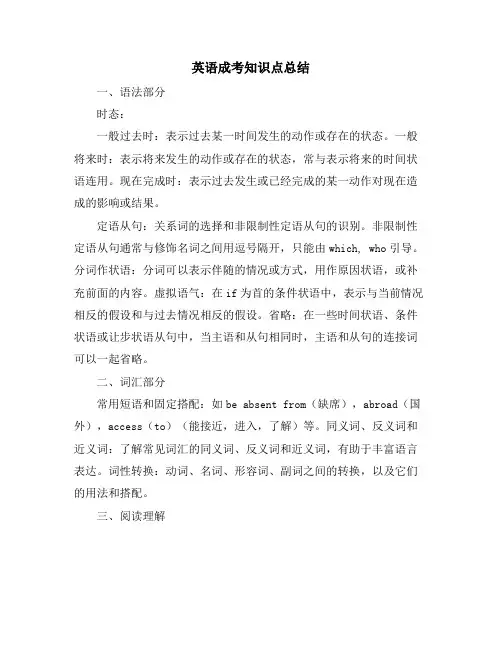
英语成考知识点总结一、语法部分时态:一般过去时:表示过去某一时间发生的动作或存在的状态。
一般将来时:表示将来发生的动作或存在的状态,常与表示将来的时间状语连用。
现在完成时:表示过去发生或已经完成的某一动作对现在造成的影响或结果。
定语从句:关系词的选择和非限制性定语从句的识别。
非限制性定语从句通常与修饰名词之间用逗号隔开,只能由which, who引导。
分词作状语:分词可以表示伴随的情况或方式,用作原因状语,或补充前面的内容。
虚拟语气:在if为首的条件状语中,表示与当前情况相反的假设和与过去情况相反的假设。
省略:在一些时间状语、条件状语或让步状语从句中,当主语和从句相同时,主语和从句的连接词可以一起省略。
二、词汇部分常用短语和固定搭配:如be absent from(缺席),abroad(国外),access(to)(能接近,进入,了解)等。
同义词、反义词和近义词:了解常见词汇的同义词、反义词和近义词,有助于丰富语言表达。
词性转换:动词、名词、形容词、副词之间的转换,以及它们的用法和搭配。
三、阅读理解理解主旨大意:能够迅速把握文章的中心思想。
细节理解:能够准确找到并理解文章中的具体信息。
推理判断:能够根据文章信息进行合理的推理和判断。
四、写作部分书信写作:掌握书信的格式和常用表达。
作文写作:能够清晰地表达自己的观点,合理使用句子结构和词汇。
这只是英语成人高考知识点的一部分,实际上还有更多的细节和知识点需要考生去学习和掌握。
建议考生根据考试大纲和历年真题进行有针对性的复习,同时注重提高自己的英语实际应用能力。
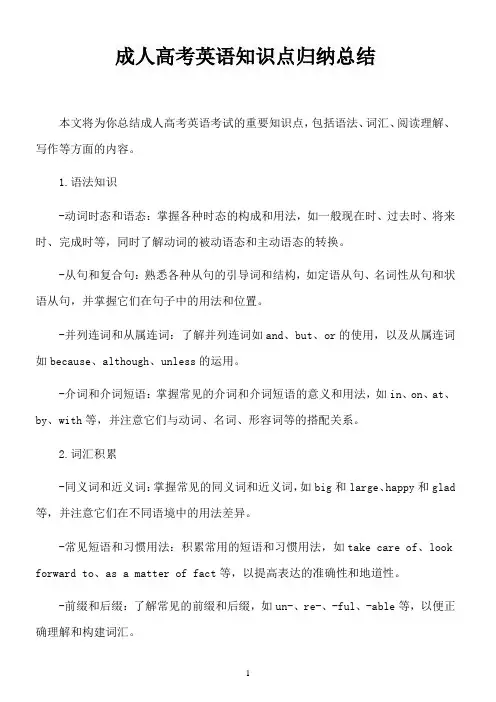
成人高考英语知识点归纳总结本文将为你总结成人高考英语考试的重要知识点,包括语法、词汇、阅读理解、写作等方面的内容。
1.语法知识-动词时态和语态:掌握各种时态的构成和用法,如一般现在时、过去时、将来时、完成时等,同时了解动词的被动语态和主动语态的转换。
-从句和复合句:熟悉各种从句的引导词和结构,如定语从句、名词性从句和状语从句,并掌握它们在句子中的用法和位置。
-并列连词和从属连词:了解并列连词如and、but、or的使用,以及从属连词如because、although、unless的运用。
-介词和介词短语:掌握常见的介词和介词短语的意义和用法,如in、on、at、by、with等,并注意它们与动词、名词、形容词等的搭配关系。
2.词汇积累-同义词和近义词:掌握常见的同义词和近义词,如big和large、happy和glad 等,并注意它们在不同语境中的用法差异。
-常见短语和习惯用法:积累常用的短语和习惯用法,如take care of、look forward to、as a matter of fact等,以提高表达的准确性和地道性。
-前缀和后缀:了解常见的前缀和后缀,如un-、re-、-ful、-able等,以便正确理解和构建词汇。
3.阅读理解技巧-主旨理解:抓住文章的主题和中心思想,通过阅读首段、尾段和标题等信息来判断文章的主旨。
-细节理解:注意细致观察文章中的关键词和信息,理解作者的意图和观点。
-推理判断:根据文章中的暗示和线索进行推理,填补文章中的信息空缺。
-内容概括:学会从全文中归纳总结出文章的要点和主要内容。
4.写作技巧-作文结构:掌握写作的基本结构,包括引入、正文和结尾,并注意段落之间的逻辑连贯。
-句子结构:运用多种句型和句式,如倒装句、条件句、比较句等,以增加句子的变化性和表达能力。
-表达准确性:注意词汇的选择和用法,避免语法错误和拼写错误,使文章的表达更加准确和流畅。
以上就是成人高考英语考试的重要知识点的归纳总结。
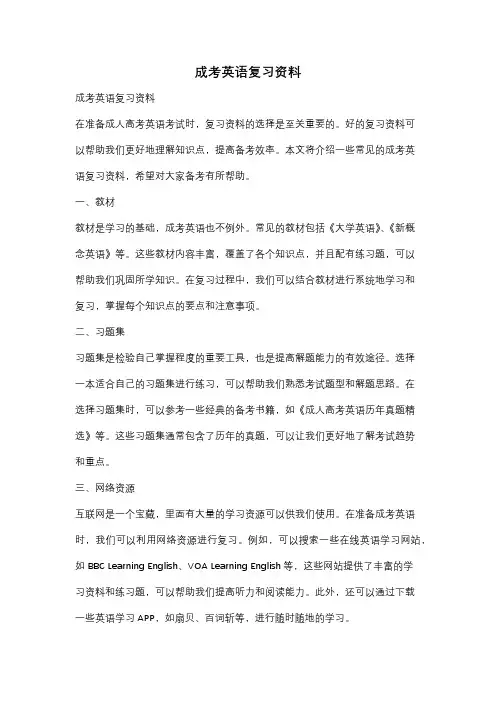
成考英语复习资料成考英语复习资料在准备成人高考英语考试时,复习资料的选择是至关重要的。
好的复习资料可以帮助我们更好地理解知识点,提高备考效率。
本文将介绍一些常见的成考英语复习资料,希望对大家备考有所帮助。
一、教材教材是学习的基础,成考英语也不例外。
常见的教材包括《大学英语》、《新概念英语》等。
这些教材内容丰富,覆盖了各个知识点,并且配有练习题,可以帮助我们巩固所学知识。
在复习过程中,我们可以结合教材进行系统地学习和复习,掌握每个知识点的要点和注意事项。
二、习题集习题集是检验自己掌握程度的重要工具,也是提高解题能力的有效途径。
选择一本适合自己的习题集进行练习,可以帮助我们熟悉考试题型和解题思路。
在选择习题集时,可以参考一些经典的备考书籍,如《成人高考英语历年真题精选》等。
这些习题集通常包含了历年的真题,可以让我们更好地了解考试趋势和重点。
三、网络资源互联网是一个宝藏,里面有大量的学习资源可以供我们使用。
在准备成考英语时,我们可以利用网络资源进行复习。
例如,可以搜索一些在线英语学习网站,如BBC Learning English、VOA Learning English等,这些网站提供了丰富的学习资料和练习题,可以帮助我们提高听力和阅读能力。
此外,还可以通过下载一些英语学习APP,如扇贝、百词斩等,进行随时随地的学习。
四、辅导书籍辅导书籍是备考过程中的好帮手。
一些著名的英语辅导书籍,如《剑桥雅思真题精讲》、《新东方考研英语词汇》等,都是不错的选择。
这些书籍通常包含了大量的例题和解析,可以帮助我们更好地理解知识点。
在选择辅导书籍时,可以根据自己的实际情况和需求进行选择。
五、听力材料成考英语听力是考试中的一个重要部分,因此,听力材料的准备至关重要。
我们可以选择一些英语听力教材进行练习,如《新概念英语听力》、《剑桥雅思听力》等。
此外,还可以通过收听英语广播、英语电台等来提高听力水平。
在听力练习中,可以多做笔记,提高听力理解和记忆能力。
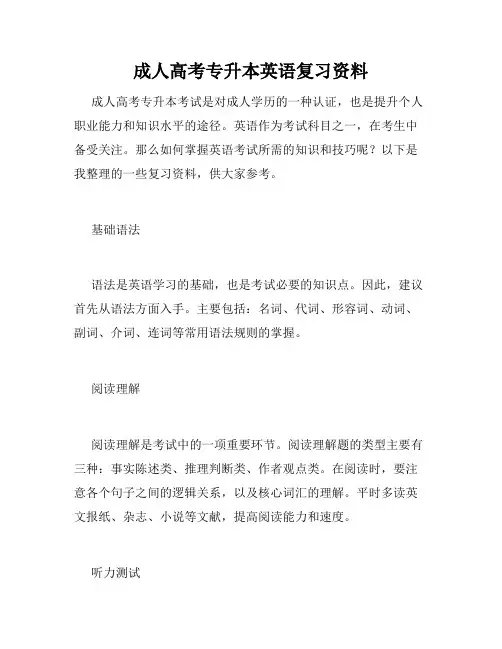
成人高考专升本英语复习资料成人高考专升本考试是对成人学历的一种认证,也是提升个人职业能力和知识水平的途径。
英语作为考试科目之一,在考生中备受关注。
那么如何掌握英语考试所需的知识和技巧呢?以下是我整理的一些复习资料,供大家参考。
基础语法语法是英语学习的基础,也是考试必要的知识点。
因此,建议首先从语法方面入手。
主要包括:名词、代词、形容词、动词、副词、介词、连词等常用语法规则的掌握。
阅读理解阅读理解是考试中的一项重要环节。
阅读理解题的类型主要有三种:事实陈述类、推理判断类、作者观点类。
在阅读时,要注意各个句子之间的逻辑关系,以及核心词汇的理解。
平时多读英文报纸、杂志、小说等文献,提高阅读能力和速度。
听力测试在考试中,听力测试的分值也相当重要。
因此,平时需多听英语电台、影视剧、英语课程等,提高听力水平。
在实际考试时,建议先仔细阅读听力材料,尤其是听力题目前的题干,预先掌握答题思路。
同时,建议采用速记法,以快速捕捉关键信息。
写作部分写作部分通常分为开头、结尾和中间三个部分,其中结尾部分尤其重要。
建议根据题目要求,演练不同的写作技巧,并结合语法知识和词汇积累,写出简洁、流畅、符合语法规则的英文表达。
同时,也可以针对各种不同类型的作文练习,比如求职信、议论文、景点介绍等。
词汇积累词汇是语言学习的基础,也是考试中必不可少的知识点。
平时需注重积累常用单词和词组,并注意它们的拼写和用法。
同时,可以在实际应用中加强记忆,比如运用单词进行口语交流、写作表达等。
总结以上是我整理的成人高考专升本英语复习资料,希望对广大考生有所帮助。
在备考过程中,建议多做真题和模拟题,以及结合自身情况进行合理规划和安排。
最重要的是保持良好的学习态度,不断提升自我,全力冲刺考试胜利。
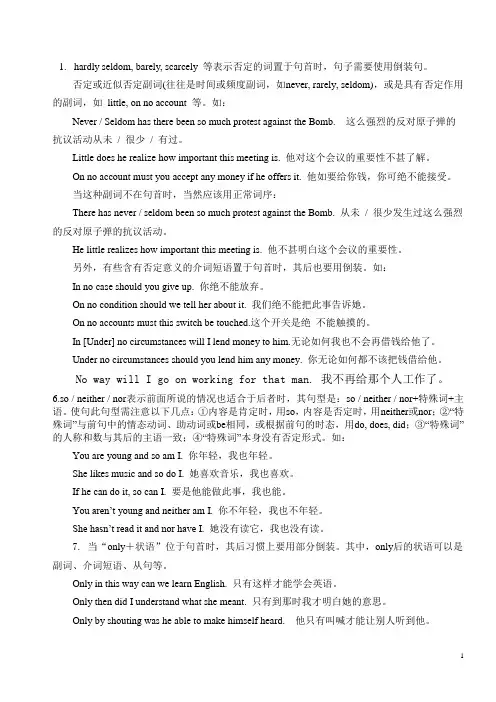
1.hardly seldom, barely, scarcely 等表示否定的词置于句首时,句子需要使用倒装句。
否定或近似否定副词(往往是时间或频度副词,如never, rarely, seldom),或是具有否定作用的副词,如little, on no account 等。
如:Never / Seldom has there been so much protest against the Bomb. 这么强烈的反对原子弹的抗议活动从未/ 很少/ 有过。
Little does he realize how important this meeting is. 他对这个会议的重要性不甚了解。
On no account must you accept any money if he offers it. 他如要给你钱,你可绝不能接受。
当这种副词不在句首时,当然应该用正常词序:There has never / seldom been so much protest against the Bomb. 从未/ 很少发生过这么强烈的反对原子弹的抗议活动。
He little realizes how important this meeting is. 他不甚明白这个会议的重要性。
另外,有些含有否定意义的介词短语置于句首时,其后也要用倒装。
如:In no case should you give up. 你绝不能放弃。
On no condition should we tell her about it. 我们绝不能把此事告诉她。
On no accounts must this switch be touched.这个开关是绝不能触摸的。
In [Under] no circumstances will I lend money to him.无论如何我也不会再借钱给他了。
Under no circumstances should you lend him any money. 你无论如何都不该把钱借给他。
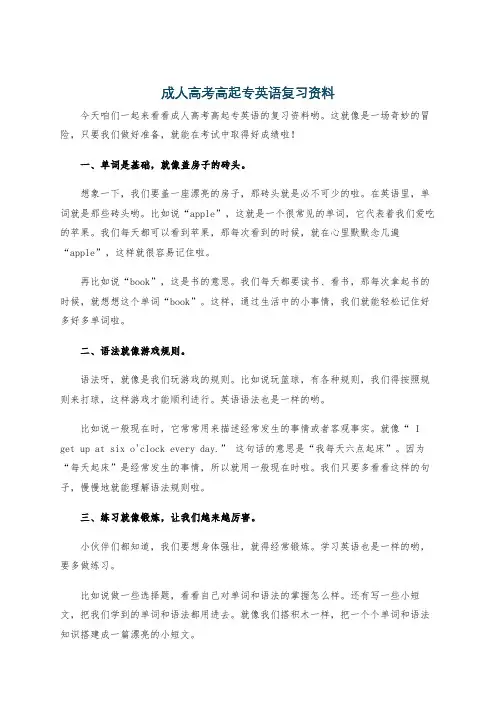
成人高考高起专英语复习资料今天咱们一起来看看成人高考高起专英语的复习资料哟。
这就像是一场奇妙的冒险,只要我们做好准备,就能在考试中取得好成绩啦!一、单词是基础,就像盖房子的砖头。
想象一下,我们要盖一座漂亮的房子,那砖头就是必不可少的啦。
在英语里,单词就是那些砖头哟。
比如说“apple”,这就是一个很常见的单词,它代表着我们爱吃的苹果。
我们每天都可以看到苹果,那每次看到的时候,就在心里默默念几遍“apple”,这样就很容易记住啦。
再比如说“book”,这是书的意思。
我们每天都要读书、看书,那每次拿起书的时候,就想想这个单词“book”。
这样,通过生活中的小事情,我们就能轻松记住好多好多单词啦。
二、语法就像游戏规则。
语法呀,就像是我们玩游戏的规则。
比如说玩篮球,有各种规则,我们得按照规则来打球,这样游戏才能顺利进行。
英语语法也是一样的哟。
比如说一般现在时,它常常用来描述经常发生的事情或者客观事实。
就像“ I get up at six o'clock every day.”这句话的意思是“我每天六点起床”。
因为“每天起床”是经常发生的事情,所以就用一般现在时啦。
我们只要多看看这样的句子,慢慢地就能理解语法规则啦。
三、练习就像锻炼,让我们越来越厉害。
小伙伴们都知道,我们要想身体强壮,就得经常锻炼。
学习英语也是一样的哟,要多做练习。
比如说做一些选择题,看看自己对单词和语法的掌握怎么样。
还有写一些小短文,把我们学到的单词和语法都用进去。
就像我们搭积木一样,把一个个单词和语法知识搭建成一篇漂亮的小短文。
举个例子哈,假如题目是描述自己的一天。
那我们就可以这样写:“ I get up early in the morning. I have breakfast and then go to school. At school, I study hard. After school, I play football with my friends. I have a good time every day.”看,这样一篇简单的小短文就写好啦,里面用到了我们学过的单词和语法哟。
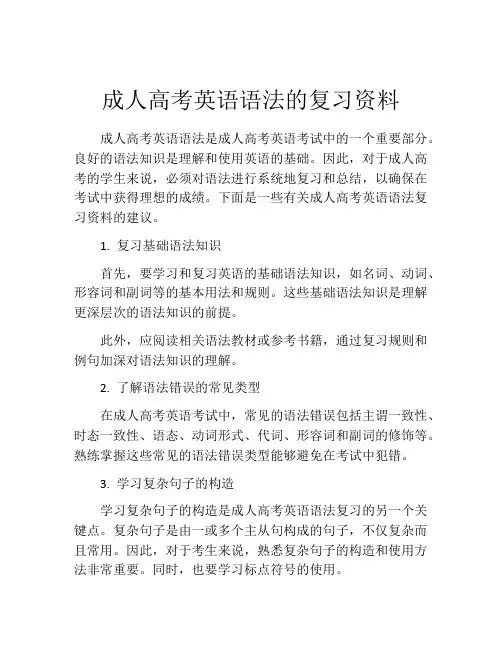
成人高考英语语法的复习资料成人高考英语语法是成人高考英语考试中的一个重要部分。
良好的语法知识是理解和使用英语的基础。
因此,对于成人高考的学生来说,必须对语法进行系统地复习和总结,以确保在考试中获得理想的成绩。
下面是一些有关成人高考英语语法复习资料的建议。
1. 复习基础语法知识首先,要学习和复习英语的基础语法知识,如名词、动词、形容词和副词等的基本用法和规则。
这些基础语法知识是理解更深层次的语法知识的前提。
此外,应阅读相关语法教材或参考书籍,通过复习规则和例句加深对语法知识的理解。
2. 了解语法错误的常见类型在成人高考英语考试中,常见的语法错误包括主谓一致性、时态一致性、语态、动词形式、代词、形容词和副词的修饰等。
熟练掌握这些常见的语法错误类型能够避免在考试中犯错。
3. 学习复杂句子的构造学习复杂句子的构造是成人高考英语语法复习的另一个关键点。
复杂句子是由一或多个主从句构成的句子,不仅复杂而且常用。
因此,对于考生来说,熟悉复杂句子的构造和使用方法非常重要。
同时,也要学习标点符号的使用。
4. 加强语法练习记住语法知识并不足以在考试中获得较高的成绩,需要进行反复练习。
成人高考英语语法复习的最佳方法就是反复进行语法题目的练习。
可以通过练习书籍或考试模拟题来熟练使用语法知识和技能。
特别是要注意不断地加快复习和练习的速度。
5. 善用网络资料现在的网络资源十分丰富,对于成人高考英语语法复习也有很多有用的网络资料。
可以收集并收藏一些网站或博客,获取其提供的语法学习材料、讲解视频和语法练习题。
总之,良好的成人高考英语语法知识是考试成功的关键。
通过反复练习和不断总结,考生可以提高应对考试的信心,并获得更高的成绩。
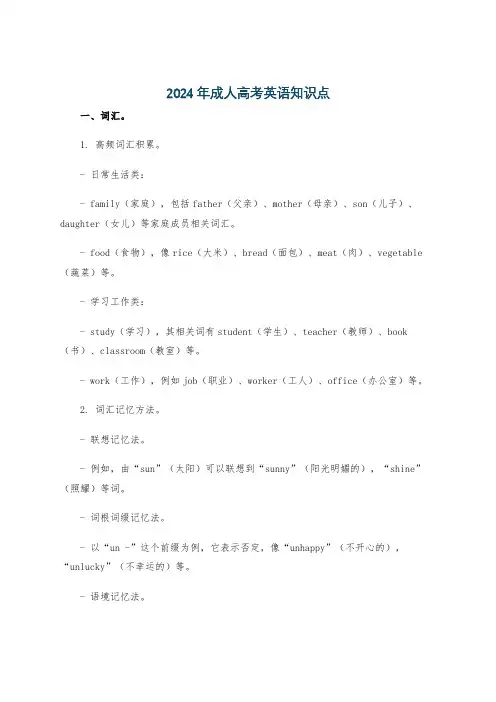
2024年成人高考英语知识点一、词汇。
1. 高频词汇积累。
- 日常生活类:- family(家庭),包括father(父亲)、mother(母亲)、son(儿子)、daughter(女儿)等家庭成员相关词汇。
- food(食物),像rice(大米)、bread(面包)、meat(肉)、vegetable (蔬菜)等。
- 学习工作类:- study(学习),其相关词有student(学生)、teacher(教师)、book (书)、classroom(教室)等。
- work(工作),例如job(职业)、worker(工人)、office(办公室)等。
2. 词汇记忆方法。
- 联想记忆法。
- 例如,由“sun”(太阳)可以联想到“sunny”(阳光明媚的),“shine”(照耀)等词。
- 词根词缀记忆法。
- 以“un -”这个前缀为例,它表示否定,像“unhappy”(不开心的),“unlucky”(不幸运的)等。
- 语境记忆法。
- 把单词放在句子或短文语境中记忆。
如:“I go to the park every Sunday.”通过这个句子来记忆“park”(公园)这个单词。
二、语法。
1. 时态。
- 一般现在时。
- 用法:- 表示经常或习惯性的动作或状态。
例如:He gets up at six every day.(他每天六点起床。
)- 表示客观事实或普遍真理。
例如:The earth goes around the sun.(地球绕着太阳转。
)- 结构:- 主语为第三人称单数(he/she/it等)时,动词用第三人称单数形式(一般在动词原形后加 - s或 - es),如:She likes reading.(她喜欢阅读。
)- 主语为其他人称时,动词用原形,如:I like music.(我喜欢音乐。
)- 一般过去时。
- 用法:- 表示过去某个时间发生的动作或存在的状态。
例如:I visited my grandparents last weekend.(我上周末看望了我的祖父母。
2024年成人高考成考英语(高起本)复习试题与参考答案一、语音知识(本大题有5小题,每小题2分,共10分)1.What is the pronunciation difference between the words “buy” and “by”?A. The vowel sound is different.B. The consonant sound is different.C. The stress is different.D. There is no difference in pronunciation.答案:A解析:“buy”中的元音音素为短音 /ɪ/,而”by”中的元音音素为长音 /eɪ/。
这两个词的元音发音不同,因此答案为A。
2.Which of the following words has a different vowel sound from the others?A. kiteB. bikeC. likeD. site答案:C解析:“like”中的元音音素为短音 /ɪ/,与其他三个选项中的元音发音不同(其他三个选项中的元音均为长音)。
因此答案为C。
3.The word “important” is pronounced as _______.A. /ˈɪmə.pərt/B. /ɪˈmɒːrt/C. /ɪmˈpɔːrt/D. /ɪmˈpɔːrtɪd/解析:单词“important” 的发音为 /ɪmˈpɔːrt/,因此正确答案为 B。
4.Which of the following words has a long vowel sound?A. CatB. HatC. DogD. Fish解析:在这四个单词中,只有“Dog”(狗)的元音音素是长元音 /ɒ/,因此正确答案为D。
5.Which of the following words has a different stress pattern from others?选项包含单词的音标及其重音位置,如:A. hon·esty(重音在第一个音节)B. rel·i·gious(重音在第二个音节)C. con·cert(重音在第一个音节)D. fa·ther(重音在第二个音节)答案:D。
30min搞定成人高考《英语》考前必背资料(含英语作文万能模板)一、动词时态及语态题掌握成人高考的词汇和语法,是考生作答所有题型的基础。
特别是其中的过去完成、过去进行时,客观真理要用一般现在时等。
1.The manager told us that this factory was built in 1958.2.By the time we got there,the play had already begun.3.When I was a child,I knew that the earth turns about its axis.4.When Mr.Delay got home after a day's exhausting work,his wife and children were sleeping.二、非谓语动词题特别是现在分词与过去分词的区别,要弄明白主动与被动这对最最重要的区别。
1.The film showed last night was very moving.(不用moved,关注-ed 形容词和-ing 形容词的区别)2.Having finishing his lecture,the teacher asked if anyone wished to asked a question.3.The problem being discussed is very important.4.Given more time,we are sure to finish it.5.Will you please make yourself known to everyone here.三、It作形式主语及形式宾语题常考点,it 本身是没有意思的,注意it 还可以指时间,天气等。
1.It is difficult to study English well.2.We think it is important to pass the exam.四、强调句型it is(was)…that…,如果前面是it is was 后面往往选用that,当然强调人的时候也可用who。
第一章语音(5分,3分钟)英语共计48个音素,其中20个元音和28个辅音,从近三年成人高考解析,集中在“a,c,g,h,i,o,u,s,y,ai,are,ch,ea,ed,ex,ere,ew,oo,ou,ow,ch,sh,th,ure”这些字母和字母组合构成的单词发音上,如:(C)1、A value B family C baby D cat(2015)(B)2、A lab B table C math D attack(2013)(D)3、A Snow B sale C ask D design(2015)(C)4、A lunch B beach C machine D chair(2015)(C)5、A check B change C chemistry D chocolate(2014)方法指导:1、找同类项法。
从4个选项中找出2个把握比较大的选项,如读音相同,则从剩余2个选项中找到与这2个读音相同的项或者不同的项(根据熟悉程度)。
如第1题,其中family,cat这2个单词我们都比较熟悉,发音为/æ/,剩余的2个单词,其中baby也是我们较为熟悉单词,发音为/ei/,故value的发音肯定是/æ/,答案选C2、排除法。
从4个选项中找出2个比较大的选项,若发音不同,则其中之一必是答案。
再从剩余2个中找出一个熟悉的,以确定这2个选项中哪一个是答案,从而排除非答案选项,如第5题,check与chemistry这2个单词,check发/ʧ/,chemistry发/k/,故其中之一必是选项,结合剩余2个单词,change较为熟悉,发/ʧ/,故答案选CAnswers:1-5CBDCC同步强化练习:(B)1、A cut B human C luck D fun(A)2、A now B show C grow D yellow(A)3、A bathe B birth C thought D thank(C)4、A potato B polite C population D polite(D)5、A feather B head C bread D beach(A)6、A cousin B south C ground D thousand(C)7、A task B respect C visit D same(B)8、A lady B july C very D busy(D)9、A hero B zero C Negro D wolf(B)10、A look B food C foot D good注:“oo”以k和d结尾的单词一般发短音/u/,其它字母结尾发长音/u:/,但food与foot是一对特例,正好相反(C)11、A bamboo B shoot C wood D cuckoo(B)12、A hour B four C flour D our(B)13、A sailor B fairy C failure D tailor(A)14、A insure B leisure C measure D pleasure(D)15、A humble B hotel C horizon D honesty注:字母“h”在常见单词hour、honer和honesty是不发音的。
2024年成人高考成考英语(高起本)复习试题及答案指导一、语音知识(本大题有5小题,每小题2分,共10分)1、In which of the following sentences is the word ‘if’ used as a conjunction?A. “It’s a good idea, if you feel like it.”B. “We’ll have a picnic if the weather permits.”C. “I’ve read the article; you needn’t, if you haven’t already done so.”D. “They can attend the meeting, provided they arrive on time.”Answer: B. The word ‘if’ in option B is used as a conjunction to introducea conditional clause.2、Which of the following sentences contains a word that is a preposition of time?A. “The train left on time.”B. “She ran across the street.”C. “We reached the summit in the morning.”D. “The movie started early, but I arrived late.”Answer: C. The phrase “in the morning” serves as a prepositional phrase of time indicating when the action took place.解析: The prepositions of time are used to express the time at which an actiontakes place. In this instance:A: The phrase “on time” refers to timekeeping and punctuality and is a prepositional phrase of time when associated with the present perfect tense, but it does not specify a particular time of day.B: “Across” is a preposition of place, indicating a direction or method of movement, not a time.C: “In the morning” denotes a time of day when the action took place, making it a prepositional phrase of time.D: The phrase “early” indicates advance or promptness in relation to time but is not a preposition of time itself.3.Which of the following words has the same vowel sound as “caught”?(A)cot(B)count(C)cause(D)courtAnswer: (D) courtExplanation: The vowel sound in “caught” is a diphthong /ɔː/, which is also found in “court”.4.Which word has the underlined letter pronounced differently?(A)there(B)thirty(C)there(D)thickAnswer: (A) thereExplanation: The underlined letter “e” in “there” is pronounced differently from the others. It’s a schwa sound /ə/, while the others are pronounced as /ɪ/.5、Which of the following words is pronounced differently from the others?A)boxB)lockC)sockD)sockAnswer: C) sockExplanation:The words “box,” “lock,” and “sock” are pronounced similarly, with the final sound being “ck.” However, “sock” is pronounced with a short “o” sound, unlike the other words which have a long “oo” sound. Therefore, the correct answer is C) sock.二、词汇与语法知识(本大题有15小题,每小题2分,共30分)1.The company decided to______its new product in Shanghai.A. launchB. hand overC. come up withD. make upAnswer: AExplanation: “Launch” means to introduce a new product or service to the market. The other opti ons don’t fit the context.2.I______have finished the project if I hadn’t been interrupted.A. mustB. shouldC. couldD. canAnswer: CExplanation: “Could have” is used to express a hypothetical past situation. It means “would have” in this case. The sentence implies the speaker was capable of finishing the project but didn’t because of being interrupted.3、Which of the following words is different from the others?A)DiseaseB)ContagionC)VirusD)PathogenAnswer: A解析: This question is asking for the word that is different in meaning compared to the others. The word “disease” is generally used to describe a general condition of poor health or illness, while the other options (contagion, virus, and pathogen) are more specific terms related to biology and microbiology.4、When writing names in accordance to American English grammar rules, which of the following is correct?A)John DoeB)Jane SmithC)Richard DawkinsD)Elizabeth OlsenAnswer: D解析: This question tests knowledge of American English name conventions. According to American English conventions, last names typically come before first names. Therefore, for the names provided, the correct format for each would be Olsen, Elizabeth; Smith, Jane; Dawkins, Richard; and Doe, John.5、The student_______working hard to pass the final exam.A.beB.isC.amD.are答案:B解析:这是一个第三人称单数句式的进行时态,用主语“student” + be动词的第三人称单数形式“is”+ 动词原形“working”。
第一部分语法知成考专升本英语-考点汇编识第一章名词一、可数名词的复数形式(一)、规则的变复数方法1、一般情况,直接+steacher---teachers ;student---students ;father---fathers ;mother---mothers2、s,x,ch,sh 结尾的单词+esdress---dresses ;box---boxes ;match---matches ;dish---dishes3、以辅音字母+y 结尾的单词:变y 为i,+escity---cities;baby---babies boy---boys*辅音字母判断方法:26个字母中,5个元音:A 、E 、I 、O 、U ,21个辅音:26-5=21个4、以“o”结尾的单词,(1)以"辅音字母+o"结尾的单数名词后+eshero---heroes;mango---mangoes;potato---potatoes;tomato---tomatoes(2)以"元音字母+o"结尾的单数名词后加+szoo---zoos bamboo----bamboos(3)某些外来词,只在词尾+sphoto----photos;piano----pianos5、以f 、f e 结尾的单词,(1)大多数变f 、f e 为“v”+es妻子:wife---wives小刀:knife---knives 狼:wolf---wolves小偷:thief---thieves架子:shelf---shelves自己:self---selves生命:life---lives一半:half---halves叶子:leaf---leaves(2)少部分直接+sroof---roofs屋顶;belief---beliefs信仰;proof---proofs证明;校样*记忆口诀:妻子拿刀去砍狼、小偷吓得发了慌、躲在架后保己命、半片树叶遮目光。
矿产资源开发利用方案编写内容要求及审查大纲
矿产资源开发利用方案编写内容要求及《矿产资源开发利用方案》审查大纲一、概述
㈠矿区位置、隶属关系和企业性质。
如为改扩建矿山, 应说明矿山现状、
特点及存在的主要问题。
㈡编制依据
(1简述项目前期工作进展情况及与有关方面对项目的意向性协议情况。
(2 列出开发利用方案编制所依据的主要基础性资料的名称。
如经储量管理部门认定的矿区地质勘探报告、选矿试验报告、加工利用试验报告、工程地质初评资料、矿区水文资料和供水资料等。
对改、扩建矿山应有生产实际资料, 如矿山总平面现状图、矿床开拓系统图、采场现状图和主要采选设备清单等。
二、矿产品需求现状和预测
㈠该矿产在国内需求情况和市场供应情况
1、矿产品现状及加工利用趋向。
2、国内近、远期的需求量及主要销向预测。
㈡产品价格分析
1、国内矿产品价格现状。
2、矿产品价格稳定性及变化趋势。
三、矿产资源概况
㈠矿区总体概况
1、矿区总体规划情况。
2、矿区矿产资源概况。
3、该设计与矿区总体开发的关系。
㈡该设计项目的资源概况
1、矿床地质及构造特征。
2、矿床开采技术条件及水文地质条件。